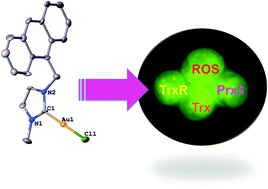Fluorescent silver(i) and gold(i)–N-heterocyclic carbene complexes with cytotoxic properties: mechanistic insights†
Abstract
Silver(I) and gold(I)–

Maintenance work is planned for Wednesday 1st May 2024 from 9:00am to 11:00am (BST).
During this time, the performance of our website may be affected - searches may run slowly and some pages may be temporarily unavailable. If this happens, please try refreshing your web browser or try waiting two to three minutes before trying again.
We apologise for any inconvenience this might cause and thank you for your patience.
* Corresponding authors
a
Dipartimento di Scienze Biomediche, Università di Padova, Viale G. Colombo 3, 35131 Padova, Italy
E-mail:
mariapia.rigobello@unipd.it
b
Fachbereich C, Anorganische Chemie, Bergische Universität Wuppertal, Gaußstr. 20, 42119 Wuppertal, Germany
E-mail:
fmohr@uni-wuppertal.de
c
Istituto di Neuroscienze (CNR) Sezione di Padova, c/o Dipartimento di Scienze Biomediche, Viale G. Colombo 3, 35131 Padova, Italy
E-mail:
alberto.bindoli@bio.unipd.it
d
Pharmacokinetics, Toxicology and Targeting, Research Institute of Pharmacy, University of Groningen, Antonius Deusinglaan 1, 9713 AV Groningen, The Netherlands
E-mail:
a.casini@rug.nl
Silver(I) and gold(I)–

 Please wait while we load your content...
Something went wrong. Try again?
Please wait while we load your content...
Something went wrong. Try again?
 Fetching data from CrossRef.
Fetching data from CrossRef.
This may take some time to load.
Loading related content
